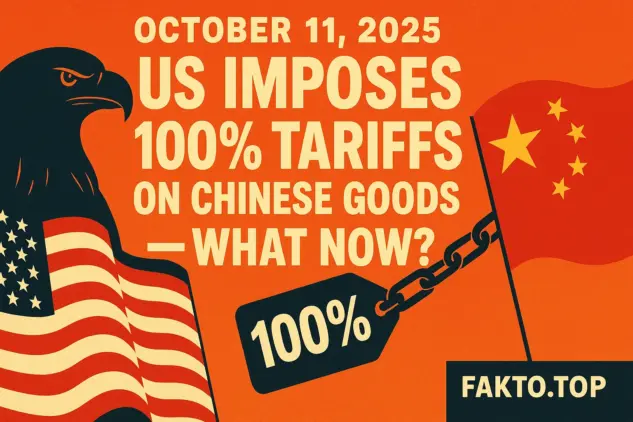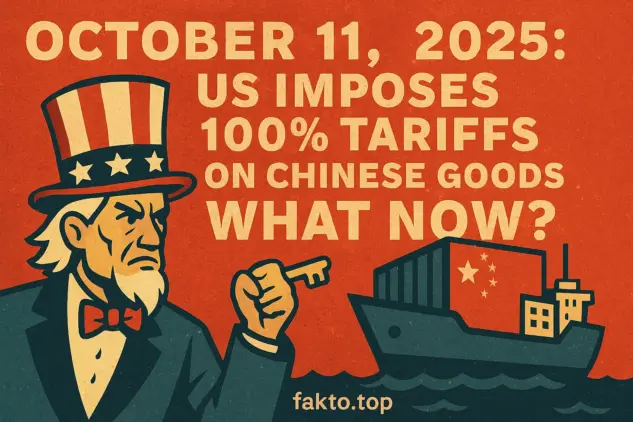US Imposes 100% Tariffs on Chinese Goods
‼️ October 11, 2025: US Imposes 100% Tariffs on Chinese Goods – What Now?
Why This Happened and the Scale of Disruption
On October 11, 2025, the United States implemented a sweeping 100% tariff on all Chinese imports. Unlike prior incremental measures, this is a full-scale escalation with immediate consequences for businesses and global supply chains.
The rationale stems from China’s tightening control over critical minerals and rare earth elements, which are essential for lithium-ion batteries, solar photovoltaic components, and Active Pharmaceutical Ingredients (APIs).
This disruption is more than a pricing issue; it represents a systemic shock to industries that have relied heavily on China’s manufacturing ecosystem.

Cryptocurrency markets were not spared; Bitcoin, often viewed as a safe-haven asset, initially plummeted by over 12% in the hours following the announcement as investors globally liquidated assets for cash, demonstrating the initial indiscriminate nature of the risk-off environment. This volatility underscored that no asset class is immune to such a sudden, geopolitical crisis.
Companies that depend on Chinese inputs face the sudden need to reassess sourcing strategies, forecast higher procurement costs, and adjust logistics timelines. Consumers are likely to experience a spike in prices for consumer electronics, household goods, and pharmaceuticals. In this context, nearshoring and friendshoring emerge as viable strategies, while the reliance on Just-In-Time inventory models is being critically challenged. The move signals to businesses worldwide that risk management, supply diversification, and proactive planning are no longer optional—they are essential for survival in a volatile global trade environment.
Market, Monetary, and Sectoral Impact
Financial markets reacted immediately to the tariff announcement. The Dow Jones fell sharply, S&P 500 and Nasdaq plunged, while commodity markets reflected uncertainty about supply disruptions. High-impact sectors include lithium-ion batteries for electric vehicles, solar panel manufacturing, and APIs for pharmaceutical production. Companies in these sectors face acute supply risk and price volatility, forcing rapid strategic reassessment. Beyond direct costs, there is a broader monetary and geopolitical effect. Tariffs accelerate the trend toward de-dollarization as international trading partners explore alternative currencies for settlement to mitigate exposure to U.S. unilateral policy changes. Meanwhile, the Chinese Yuan faces heightened volatility, creating currency risk for firms holding reserves in CNY or HKD. For investors and financial planners, this implies a complex interplay of tariffs, foreign exchange risk, and sectoral exposure. Supply chain shocks, combined with potential inflationary pressure, mean businesses must act decisively to adjust procurement strategies, hedge currency risk, and maintain liquidity. The era of uninterrupted Just-In-Time logistics is effectively over, demanding a shift toward resilience and adaptable business planning.

Immediate Questions and Considerations
Q: Which industries are most at risk? Lithium-ion battery production, solar photovoltaic manufacturing, and pharmaceutical APIs are at the highest immediate risk due to dependency on Chinese raw materials and components. Q: How should businesses assess currency risk? Companies with cash reserves in CNY or HKD should consider hedging strategies or converting to more stable currencies to buffer against sudden exchange rate fluctuations. Q: How urgent is supply chain diversification? Extremely urgent. Firms need to explore nearshoring (e.g., Mexico, Vietnam) and friendshoring (e.g., Canada, Europe, India) options to reduce exposure to sudden disruptions and tariff shocks. The focus must shift from cost minimization to resilience and security of supply.
China’s Response: Strategic Countermeasures and Broader Threats
China did not take the U.S. 100% tariff announcement lightly. In addition to imposing higher port fees for American-linked vessels—starting at 400 yuan ($56) per net ton and increasing annually—Beijing is strategically tightening control over rare earth exports and other critical minerals. This is not just a logistical adjustment; it is a deliberate signal of China’s leverage over global supply chains. For companies dependent on lithium, cobalt, and key pharmaceutical ingredients, the stakes have never been higher. Analysts warn that these measures could delay production, increase costs, and create uncertainty in sectors like renewable energy, electric vehicles, and high-tech manufacturing. Port fees, though concrete, are just the visible tip of a deeper strategic threat: restricted access to essential raw materials and production inputs. For multinational corporations, this moment is a wake-up call—businesses that rely solely on Chinese sources are extremely exposed. Yet, there is a subtle opportunity for companies ready to diversify, build relationships with trusted allies, and rethink their sourcing strategies before disruptions become critical.
Supply Chain Strategies and Risk Mitigation
The 100% tariffs have forced businesses to reconsider long-standing supply chain models. Nearshoring—moving production to nearby countries such as Mexico or Vietnam—can mitigate logistical delays and reduce exposure to sudden tariff hikes. Friendshoring—shifting production to trusted allies like Canada, India, or the EU—addresses geopolitical and security risks, ensuring supply continuity even during international tensions.

Another essential change is the shift from Just-In-Time (JIT) inventory to Just-In-Case (JIC) models, where firms maintain larger inventories to buffer against sudden shocks. Stockpiling critical components, such as lithium-ion battery materials or API precursors, may feel counterintuitive in cost-conscious environments, but it is now a strategic necessity. Companies also need to integrate financial hedging strategies to manage currency risks, particularly for cash reserves in CNY or HKD. Leaders must adopt resilience-focused planning rather than short-term efficiency, balancing cost increases against the imperative of uninterrupted production. Firms that act proactively may gain a competitive advantage as competitors scramble reactively, making strategic foresight more valuable than ever in this turbulent environment.
Legal and Compliance Considerations
Beyond operational adjustments, the new tariffs introduce immediate legal and compliance risks. Companies must urgently review existing contracts for Force Majeure clauses that could protect them from unforeseen tariff changes. Ignoring these clauses could lead to disputes with suppliers or customers. Customs compliance has become more complex, with heightened penalties for misclassification, underpayment, or failure to adapt to the 100% tariff structure. Legal teams should work closely with operations to ensure that import/export documentation, reporting, and tariff codes are fully updated. Failing to do so can result in severe fines, shipment delays, or regulatory scrutiny. Understanding these legal dimensions is as critical as logistical and financial adjustments; companies that overlook this area are leaving themselves exposed to avoidable risks, compounding the already intense pressure from market and supply chain disruptions.
Global Supply Chain Adaptation Matrix
| Sector/Industry | Primary Impact | Recommended Strategy | New Risk |
|---|---|---|---|
| Lithium-Ion Batteries / Solar Components | Severe supply risk & price volatility | Friendshoring (Allies), JIC Inventory | Dependence on South America/Africa raw materials |
| Pharmaceutical APIs | High disruption & quality risk | Nearshoring (Vietnam/India), JIC Inventory | Regulatory hurdles & export restrictions |
| Consumer Electronics | Price spikes & delayed availability | Nearshoring (Mexico), Supplier Diversification | Shipping congestion, currency volatility |
| Automotive Components | Severe supply chain risk & increased costs | Friendshoring, Inventory Stockpiling | Labor cost increases & geopolitical risk |
Actionable Takeaways for Businesses
Immediate steps are crucial. First, diversify supply chains across both nearshore and friendshore locations to reduce exposure to sudden tariff shocks. Second, adopt Just-In-Case inventory models to buffer against production delays and price volatility. Third, review all contracts for Force Majeure clauses and align legal strategies with operational realities. Fourth, actively hedge currency risk and monitor USD/CNY dynamics. Fifth, collaborate with industry partners and associations to share insights, advocate for policy clarity, and explore innovative logistics solutions. While the current situation is stressful, businesses that respond quickly and strategically can transform uncertainty into a competitive edge. Planning, adaptability, and proactive risk management are now essential components of corporate strategy, not optional practices.
Final Q&A
Q: What is the difference between Nearshoring and Friendshoring?
A: Nearshoring moves production to nearby countries (e.g., Mexico, Vietnam) to reduce logistical delays and shipping costs. Friendshoring shifts production to politically trusted allies (e.g., Canada, EU, India) to mitigate geopolitical and security risks. Both approaches aim to diversify supply and increase resilience against trade disruptions.
Conclusion: Entering the Era of Resilience Economics
The 100% tariffs mark a historic shift in global trade dynamics. The JIT model is effectively dead; businesses must now embrace resilience economics—prioritizing supply chain security, strategic diversification, and proactive planning over mere cost optimization. Companies that adapt quickly, integrate nearshoring and friendshoring, maintain JIC inventory, and address legal compliance will not only survive but potentially gain a competitive advantage. The era of uncertainty is challenging, yes, but it also rewards foresight, strategic creativity, and adaptability. This is a moment for decisive action, and for businesses willing to evolve, the path forward is filled with opportunity despite the turbulence.
